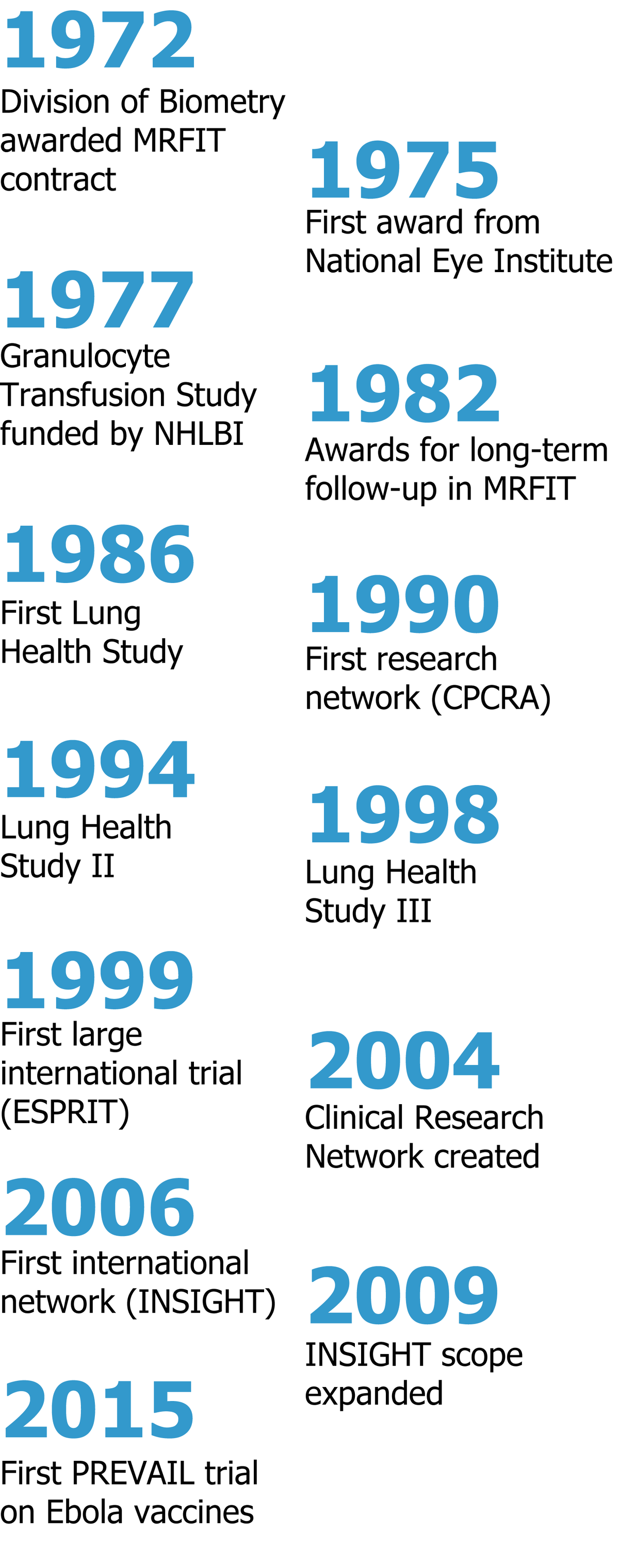The CCBR’s origins date back to 1972 when the University of Minnesota’s Division of Biometry (now the Division of Biostatistics) in the School of Public Health was awarded a contract from the National Heart and Lung Institute (now the National Heart, Lung, and Blood Institute [NHLBI]) to conduct the Multiple Risk Factor Intervention Trial (MRFIT). Dr. Marcus Kjelsberg was the principal investigator (PI) with Drs. Glenn Bartsch and Lael Gatewood as co-investigators. Shortly after receiving funding, Jim Neaton was hired. A few months later Victor Grambsch was hired; he led the design of a data management system that included many features still in use today. Over 350,000 men were screened for MRFIT and 12,866 participants were randomized at 22 clinical centers in the United States. In 1998, JAMA selected the 1982 MRFIT main results paper as one of 24 “important groundbreaking and practice-changing articles” and reprinted it in its entirety.
The division expanded its scope, conducting more trials and working with other institutes at the National Institutes of Health. In 1975, Dr. Bartsch received funding from the National Eye Institute (NEI) to conduct the Diabetic Retinopathy Vitrectomy Study. In 1977, the Granulocyte Transfusion Study was funded by NHLBI to investigate treatments for transplant recipients at risk of infection with Dr. John E. Connett, a former post-doctoral fellow who worked on MRFIT, as PI.
The 80s brought more trials, including the Prism Adaptation Trial and the Visual Acuity Impairment Survey pilot funded by NEI with Dr. Connett as PI, and the Mt. Sinai Hypertension Trial and the Treatment of Mild Hypertension Study funded by NHLBI. The hypertension trials were in large part an outgrowth of findings from MRFIT. These trials represented expanded collaborations among Drs. Richard Grimm and Ron Prineas in the Division of Epidemiology with Dr. Neaton, who led the coordinating centers for these studies.
Following the completion of the intervention phase of MRFIT in 1982, grants with Drs. Kjelsberg and Neaton as PIs were received to carry out long-term mortality follow-up of both the men screened and randomized. The MRFIT grants continued into the mid-90s and resulted in many important papers.
In 1986, the CCBR expanded into research on lung disease. Drs. Kjelsberg and Connett as PIs were awarded an NHLBI contract for the Lung Health Study (LHS). The LHS enrolled 5,887 smokers at 10 centers in the United States and Canada and examined the effects of medication versus smoking cessation on the rate of lung function decline. This led to the LHS II in 1994, which examined the effects of inhaled corticosteroids on more than 1,000 participants, and the LHS III in 1998, which provided long-term follow-up of the original LHS participants.
In 1990, the University of Minnesota was awarded a contract from the National Institute of Allergy and Infectious Diseases (NIAID) with Dr. Neaton as PI to be the Statistical and Data Management Center for the Terry Beirn Community Programs for Clinical Research on AIDS (CPCRA). At the time, there were few treatment options for individuals with HIV/AIDS. The CPCRA conducted community-based research at sites across the US in diverse clinical settings. CPCRA protocols focused not only on antiretroviral therapy (ART) to slow the progression of HIV and drugs to prevent and treat opportunistic infections, but also investigated adherence, nutrition and acupuncture.
The first international trial conducted by the CCBR was the Evaluation of Subcutaneous Proleukin® in a Randomized International Trial (ESPRIT), which was funded in 1999. With 252 sites in 26 countries, ESPRIT enrolled 4,150 participants and followed them until 2008. The ESPRIT trial was conducted with a novel organization structure that included three international coordinating centers.
International collaborations on HIV expanded to South Africa in 2005. With the South African Military Health Service and NIH, staff at the CCBR collaborated on Project PHIDISA to conduct research on HIV within the South African Military environment. A large clinical trial of ART was conducted as well as epidemiological studies. As part of this collaboration, staff at the CCBR built a data management system in South Africa and trained South Africans to coordinate the research.
In 2006, the CPCRA and ESPRIT groups merged to form the International Network for Strategic Initiatives in Global HIV Trials (INSIGHT) to conduct HIV treatment trials with Dr. Neaton as PI. INSIGHT is a global clinical research network of over 300 sites in 37 countries. Like ESPRIT, INSIGHT included international coordinating centers – now four in Copenhagen, London, Sydney and Washington DC. INSIGHT's scope broadened beyond HIV in 2009 to include influenza research.
INSIGHT conducted the SMART and START trials, which led to changes in HIV/AIDS treatment guidelines worldwide. These two trials along with a trial called HPTN 052 that was conducted by the HIV Prevention Trials Network have been described as the “triad of critical clinical trials…that settled the debate concerning early initiation of ART.”
While work on HIV and influenza became part of the work of the CCBR beginning in 1990, work on other diseases continued. In 2004, the University of Minnesota was awarded an NHLBI contract with Dr. Connett as PI for the COPD Clinical Research Network (CRN), which conducted trials on COPD treatments until 2015. Trials included the MACRO study, which looked at the effects of a macrolide antibiotic (azithromycin) on exacerbations in 1042 participants and STATCOPE, which examined the use of statins.
In late 2014, the CCBR was contacted by NIAID to work on a response to an ongoing Ebola epidemic in West Africa. CCBR staff collaborated with colleagues at NIH and in Liberia as part of the Partnership for Research on Ebola Virus in Liberia (PREVAIL) on the design, conduct and analysis of vaccine and treatment trials as well as epidemiological investigations of the long-term clinical effects of Ebola among survivors of the disease. Much of this work continues, and collaborations have expanded to other countries in West Africa.
